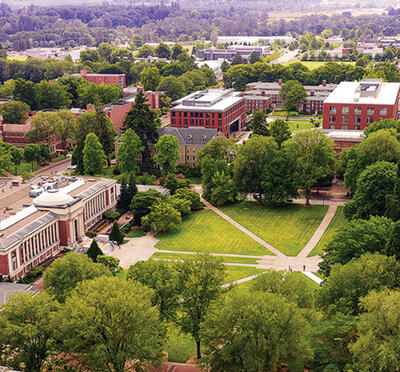Tzu-Yi Chang, a doctoral student in nuclear engineering at Oregon State who spends her summers conducting research at the Idaho National Laboratory, has been fascinated by how things function ever since she was a child.
“I started my engineering education when I was young, since my father was a technician,” Chang said. “I watched him work when I was as young as 4 or 5 years old and learned about machines.”
Chang attended a vocational high school in Taiwan, her home country. She decided to study mechanical design because she was comfortable around machines, and she enjoyed the creative outlets of painting, drawing, and sketching. Next, she earned her bachelor’s degree in mechanical engineering from the National Taiwan University of Science and Technology, where she deepened her knowledge of physics and mechanics.
“I wanted to design products that can be used in the real world,” Chang explained. “That’s why I chose mechanical engineering. Then, I realized how critical the materials were.”
For her master’s research at Oregon State, Chang used computational simulation to learn how materials function at an atomic level. Advised by Donghua Xu, assistant professor of materials science, her dissertation research entailed a molecular dynamics simulation of metallic glass, a durable, shiny material with a unique atomic structure.
“The glass is actually a new type of strong, tough metal with unique mechanical properties,” Chang said. “It’s applied in the medical area to make surgical knives and needles. It has less friction, meaning you won’t feel as much pain. But it’s hard to produce because of its atomic interactions. Our main goal for this research was figuring out how it works and improving the manufacturing process by understanding the physics behind it.”
Chang gained practical experience in Taiwan through her summer internship as a processing engineer with Taiwan Semiconductor Manufacturing Company, where her work centered on the semiconductor production process.
“I analyzed data to see how good or bad the product was,” Chang said. “When we observed something wrong, we worked on the machines and adjusted some parameters to increase the production speed.”

When at the Idaho National Laboratory, she works with her Corvallis-based advisor, Tianyi Chen, assistant professor of nuclear science and engineering, on a project involving nanoindentation, a method for testing localized material properties, such as hardness, stiffness, and elasticity, using a small amount of the material.
Specifically, Chang and Chen are focused on the material property of creep, a type of deformation that increases with time as the material structure changes under mechanical stress and rising temperatures. Because creep reduces the life of nuclear fuel, understanding this phenomenon better could lead to ways to improve the nuclear fuel cycle.
“We want to use small-scale techniques for material testing to understand creep, or how the microstructure of a material evolves under different detailed conditions,” Chang explained. “The process is usually complicated because it involves many different interactions and an evolving microstructure simultaneously. We look forward to learning more about it and using our results to interpret and predict larger-scale material properties.”
At INL, Chang uses a scanning electronic microscope to analyze how materials deform and change shapes. Her advisor, Chen, has been collaborating with INL since 2021, leading to the School of Nuclear Science and Engineering receiving its own SEM-focused dual ion beam system from INL, which is currently being installed on campus. Small-scale atomic analysis made possible via SEM can help Chang and other researchers suggest ideal materials for certain manufacturing contexts.
“We also want to create a universal formula or equation for other materials so that we can predict material properties by equations without always having to do lab experiments,” she said.
Chang has three more years to continue excelling in her program, and she hopes to extend her fellowship with INL. Once she earns her doctorate, she wants to return to Taiwan to teach; when it comes to the nuclear engineering field, she believes there are plenty of research areas and a variety of jobs that contribute to society. Chang hopes STEM students internalize this as they gradually understand and harness the positive capabilities of nuclear science.
“Many people in Taiwan don’t have much knowledge about this,” Chang explained. “Through teaching my students how we can use more eco-friendly nuclear energy to produce electricity, I can help my country further build our own nuclear program.”



